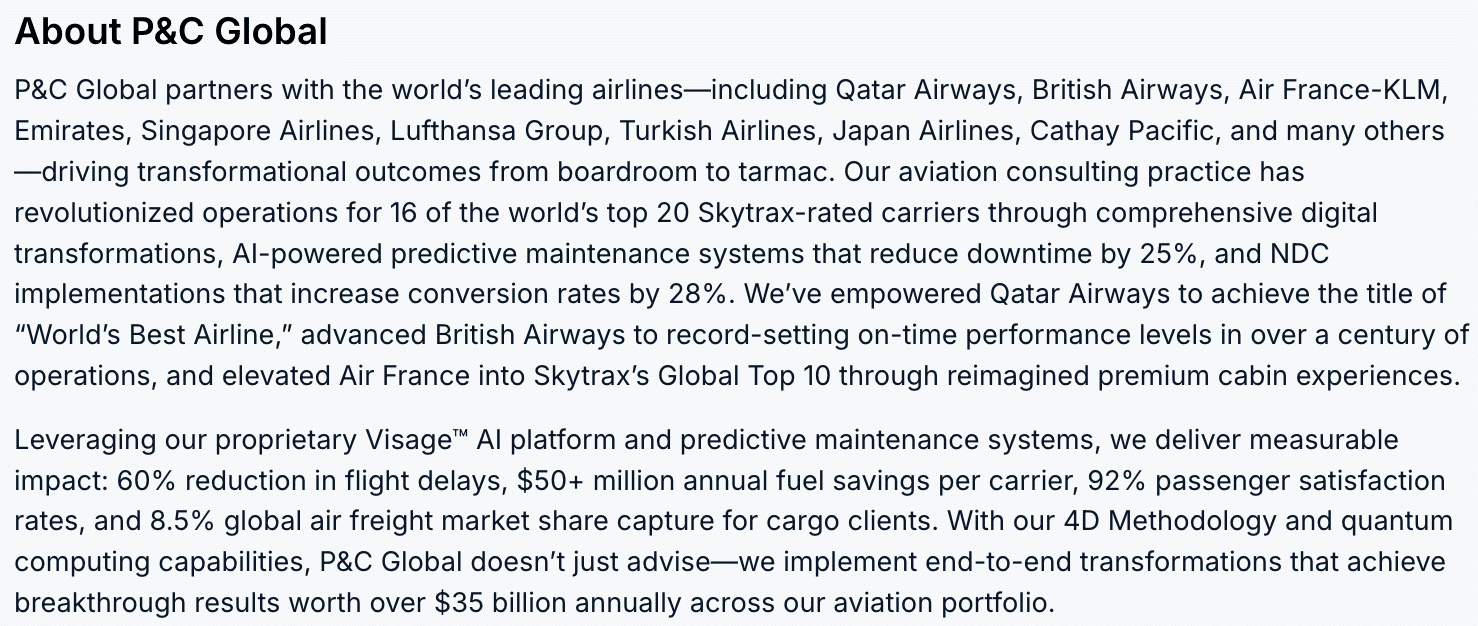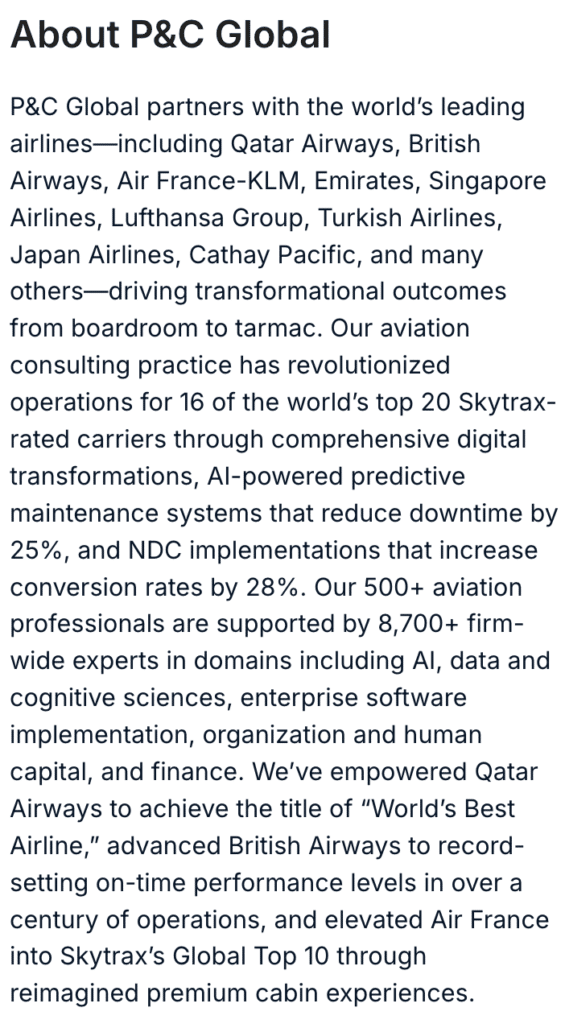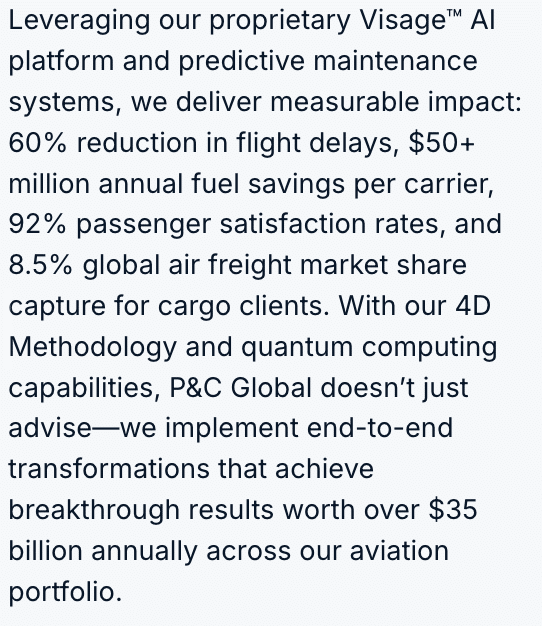


Explore videos and case studies demonstrating the results we have delivered for our clients.
Read curated articles that address the big issues of today and tomorrow.
Learn about P&C’s global footprint and how we engage with clients.
In the age of fierce competition for market share and customer lifetime value, leading airlines are rethinking how they connect with passengers—not just through service, but through sensation. From the moment a journey begins, every element of the environment shapes perception. Increasingly, the world’s top carriers are turning to sonic branding and multi-sensory experience design to elevate travel experience, reduce friction, and foster loyalty.
This shift reflects a broader evolution, where experience design has become a strategic lever for competitive differentiation in travel and hospitality. Drawing from our work with global carriers and luxury travel brands, we’ve seen how multi-sensory strategies can reframe loyalty, differentiate commoditized offerings, and deliver measurable impact across the full passenger journey.
Scent, sound, light, texture, and rhythm—these are no longer afterthoughts. They are strategic tools. Executed well, multi-sensory branding reinforces identity, sets emotional tone, and turns the abstract concept of a brand into a tangible, felt experience.
For airlines navigating intense competition and rising expectations, these touchpoints are becoming the new front line of differentiation.
Travelers today don’t just buy tickets—they collect moments. A growing body of research demonstrates that emotionally rich, sensory-led experiences are more likely to be remembered, shared, and revisited. In high-stress environments like airports and cabins, subtle sensory cues—like a calming sonic theme or a comforting scent—can have a disproportionate impact on customer satisfaction and brand affinity.
Even a short sonic logo—a distinctive sound or musical phrase—can powerfully encapsulate a brand’s identity. Much like a visual logo, it delivers instant recognition, but through emotionally resonant sound. When deployed consistently across key touchpoints, from boarding announcements to mobile apps, it reinforces brand familiarity, signals quality, and leaves a lasting emotional imprint on the passenger experience.
More airlines are embracing a multi-sensory approach to enhance the passenger journey, using sight, sound, scent, and texture to create emotional resonance and brand distinction. Singapore Airlines, for example, emphasizes a five-senses approach: a signature batik scent, harmonious cabin lighting, locally inspired cuisine, world-class hospitality and furnishings, and a custom musical composition that plays during boarding and landing. These elements are not simply ornamental—they are purposeful, crafted to ease anxiety, reinforce cultural identity, and deliver consistency across the passenger journey.
Airlines today must operate beyond operational excellence to drive meaningful gains in corporate performance for travel and hospitality. Brand loyalty is increasingly forged not only by punctuality or price, but by how passengers feel across every phase of their journey.
Four forces are accelerating investment in sensory strategy:
From lie-flat seats to streaming entertainment, premium features have become industry standard. Emotional experience is now the differentiator.
Travelers today expect more than functional service—they seek comfort, calm, and emotional assurance throughout their journey. Sensory design plays a vital role in meeting these elevated expectations, providing cues that can reassure, uplift, and soothe in ways that traditional signage or service interactions alone cannot.
With the proliferation of voice interfaces, apps, and contactless travel, sound and other non-traditional design cues have become primary brand identifiers. A sonic logo, for example, can be as distinctive as a visual one.
As airlines expand into diverse markets, sensory branding allows for subtle, culturally attuned localization—without diluting the core brand.
At P&C Global, we help leading carriers reimagine passenger experience through sensory-led transformation, powered by our Strategy & Innovation practice.
Sonic branding is only one facet of a larger sensory strategy. As global travel brands raise the bar, the most forward-thinking airlines are now integrating:
These choices are not incidental. Each one contributes to a multi-sensory brand environment that feels curated, intentional, and emotionally resonant.
P&C Global partnered with one flagship carrier to define and launch its first-ever sonic brand identity. The project began with an immersive exploration of national heritage, passenger psychology, and acoustic branding principles. From there, a bespoke sonic palette was developed—one that reflected cultural roots, embodied elegance, and conveyed reliability and warmth.
This sonic identity now features across the passenger journey: in pre-flight communications, boarding and in-flight announcements, lounges, and digital touchpoints. The soundscape reinforces a sense of familiarity and trust while offering moments of calm in otherwise high-stress environments.
This holistic approach is not theoretical. In another engagement, P&C Global supported a global airline in translating its brand identity into a fully orchestrated sensory experience. This included everything from lighting and visual design to onboard scent, service choreography, and even the development of an original musical composition.
Every sense was considered. The result? A multi-sensory brand ecosystem that increased passenger satisfaction, enhanced emotional connection, and became a hallmark of the airline’s brand evolution.
Great service gets remembered. Exceptional sensory design leaves an impression that lasts far beyond the journey. For airlines seeking to differentiate in commoditized markets, connect with passengers on a human level, and ultimately deepen loyalty, the next competitive edge may not be a new seat or route—but how the journey sounds, smells, looks, and feels.
At P&C Global, we help clients orchestrate brand-defining experiences that move beyond function to forge emotional resonance—and lasting loyalty.


